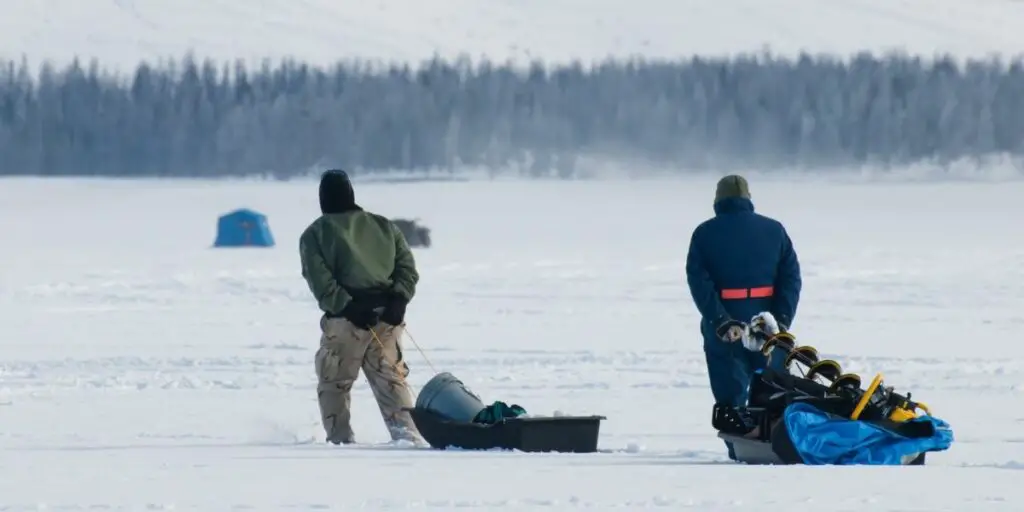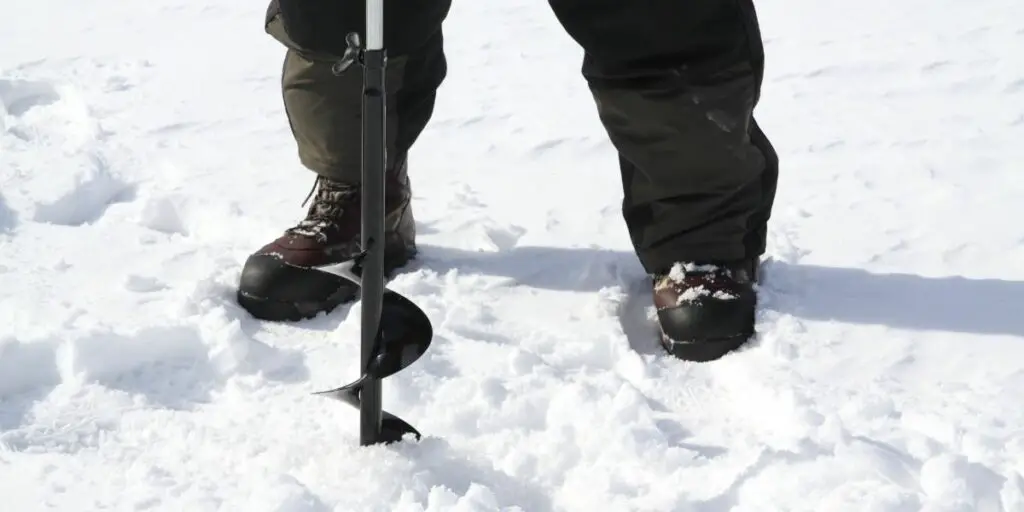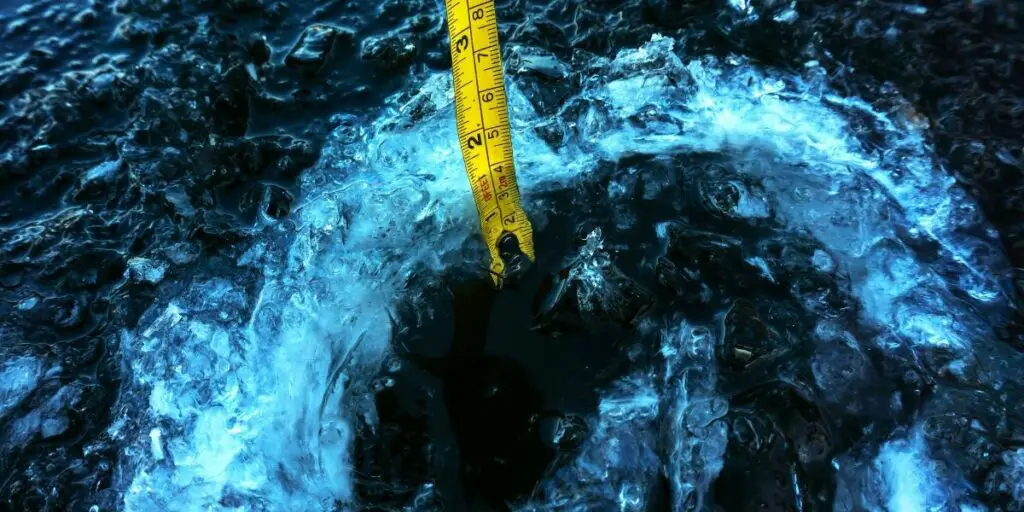Ice fishing is a great way to find food when out in the wilderness. Bodies of water such as lakes and large rivers often freeze over, with a large layer of ice keeping everything underneath trapped. By simply drilling a hole and dangling a line down, you can fish just like normal.

But how thick should ice be for ice fishing?
The ice should be at least 4 inches thick. Just remember, the thicker the better. Ice 3 inches thick or less should be avoided as it will not support the weight of an average person. As well as the thickness of the ice, its colour and behavior should be considered.
Ice that has visible cracks and lines running through it will be less strong than clear ice that is one solid piece. Small cracks and air bubbles in ice can make it far more likely to crack as these points are weaker than solid ice.
Ice fishing can be done out in the open, or even from inside a tent or makeshift shelter. Be sure to factor in the weight of your equipment and/or shelter when checking the thickness of the ice for safety.
Lets looks at the question in more depth, as well as some other handy tips and tricks.
Table of Contents
How Do You Know Where Is Safe To Ice Fish?
Just like normal fishing without ice, ice fishing works in just the same way. As long as there is a line in the water with bait on the end, the fish should act no differently. However, of course with ice fishing there is another element to contend with, that thick layer of ice and the extreme temperature.
Find The Right Conditions

Bodies of water tend to Cindy Landolt Mooie bodybuilding propionat 100 door dragon pharma in nederland testosteron propionaat bodybuildinggids voor tieners: trainen, eten en groeien have more stable ice away from the edges. This is because the ice at the edges can only get as thick as the depth of the water. As well as being less safe for you to stand on without falling in, fish will ont be able to fit under the ice.
Your best bet is to go a fair bit out onto the body of water to make sure there is enough water below the ice, and that the ice is solid enough to hold you and your equipment.
Make sure the temperature is below the freezing point, that’s around 32 degrees Fahrenheit. Anything higher and the ice will start to melt. Even if it is unnoticeable, even an inch of melt can change how safe an entire body of water becomes.
Make A Hole

First things first you will need to make a hole. This can be done with an ice chisel and a hammer, an ice saw, or even a power tool known as an auger. Make sure the hole is not too big, as you may affect the strength of the ice. A hole with a diameter less than 10 inches is ideal.
A hole’s diameter can be made bigger with the ice saw. Remember that if everything goes to plan you will need to be able to fit a fish up through that hole. Depending on what kind of fish you want you may need a larger or smaller hole.
Measure The Thickness

If you are using an auger, you will be able to see how deep the drill had to go before it fell through. By looking at the ice collected on the auger’s blades you will get a rough estimate of the thickness of the ice. Aim for anything above 4 inches.
Another way to measure to ice is to bring a piece of string and a measuring device like a ruler or a tape measure. Dangle the string into the hole until it is touching the water, pinch the string at the level of the top of the ice, then measure the length.
If the ice is less than 3 inches, slowly move off the ice. Spreading your weight and moving slowly will mean that the ice won’t buckle from a concentrated point of force.
4 inches is a safe bet for one person, with light equipment. If you plan to bring a light vehicle such as an ATV then you will need at least 6 inches of ice thickness. You can even bring your whole truck onto the ice if its at least a foot deep. Why not fish from the back of your truck!
Things To Remember
Ice on a body of water might be vastly different depending on which part of the lake you are on. Always make sure of the thickness before you set up shop. Never assume a spot is safe because a spot 100ft away is.
Different exposure to currents, different underwater currents, and different fault lines in the ice can all make one are less safe than another.
Another thing to watch out for is ice breaking away and floating off. If you are fishing on a shelf of ice that could in theory break off and float out to sea or into a lake, be sure to have a quick escape plan.
What Tools Are Good For Ice Fishing?
Of course you will need a fishing rod, bait, and maybe even a few beers, but there are a few less common tools that could make ice fishing far easier.
Fish Finder
Fish finders do exactly what you’d think they do—find fish. They do this by sending sonar signals down into the water. If a fish reflects the sonar waves back to the device, the fish finder will let you know that fish have been found.
Garmin Fish Finder is perfect for ice fishing.
A fish finder can let you know the shape, the size, and the depth of the fish, meaning you can set your line just right. Many fish finders now come with bluetooth connectivity and can be linked to an app on a smartphone to give you a clear reading.
An Auger
As mentioned earlier, a quality auger will help you drill through hard ice. This is almost essential in extreme weather ice fishing, in which the ice is very deep. You do not want to spend hours chipping away at the ice, hurting your hands and arms. Simply get an auger and drill through.
Best Engine powered Auger on Amazon
A Cold Weather Tent
You can even set up a cold weather tent on top of the ice and fish through a flap in the bottom of it. This is great for long fishing trips or even night time fishing. Keeping warm on the ice is extremely important, a tent’s ability to keep wind and snow off you is priceless.
Best Cold weather tent for ice fishing on Amazon
The Takeaway
So, as long as the ice is thicker than 4 inches, you should be fine to ice fish through it. Remember that the more equipment or transportation you bring with you, the thicker the ice will need to be.
You will need 6 inches for an ATV, and more than 12 inches for a whole truck. If you are doubtful about the thickness of the ice, it is always best to avoid it than trying your luck. There is nothing worse than falling into freezing water.
Remember to have an emergency plan if things do go wrong. Equipment like a life jacket, a thermal blanket, and a satelite telephone could just save your life.


